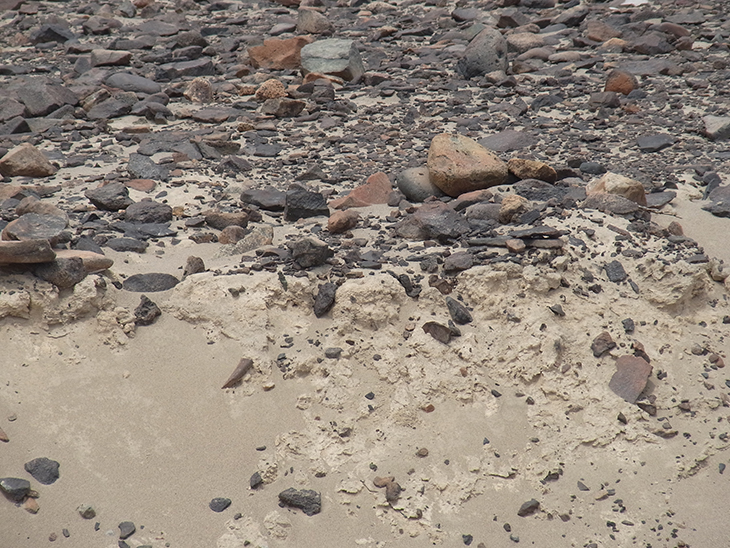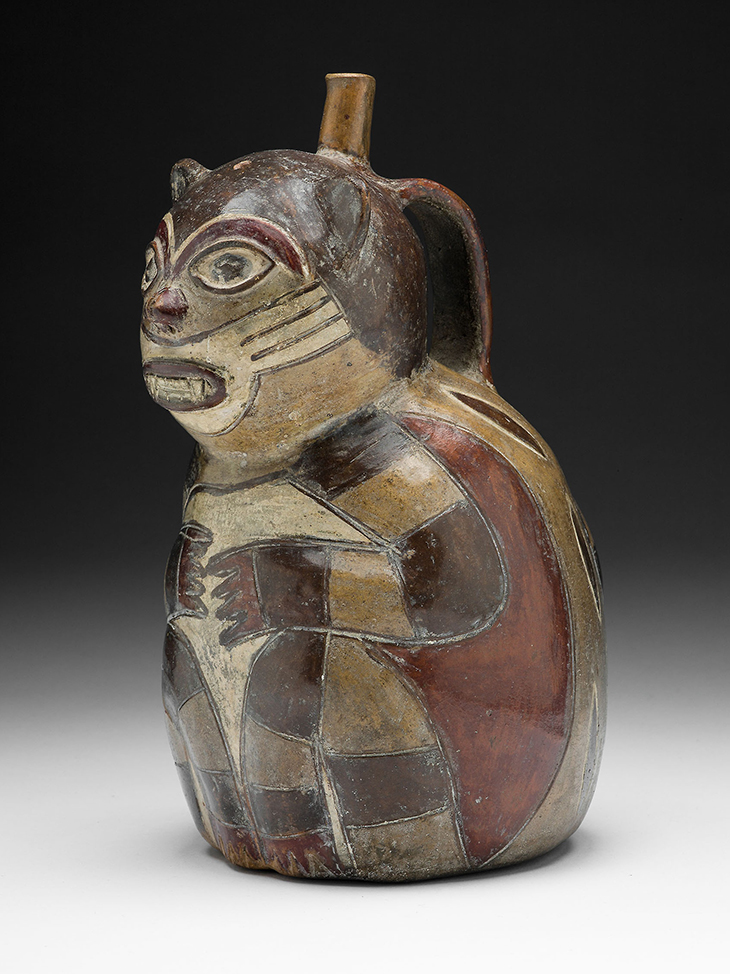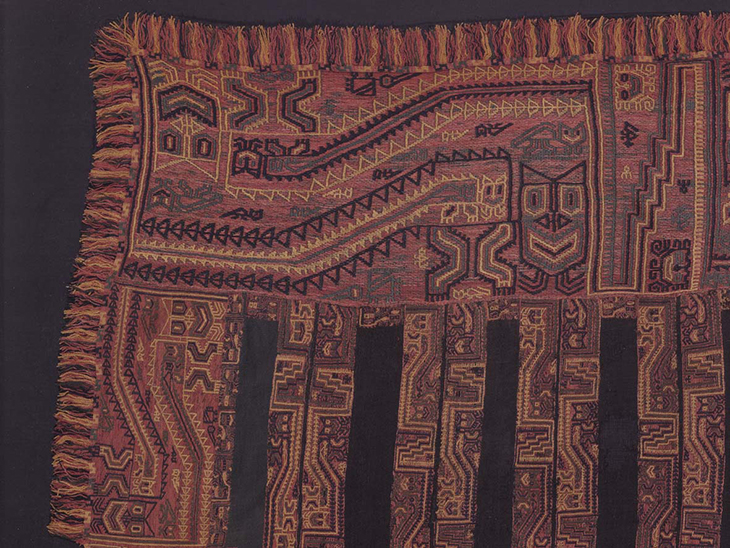What baffles modern viewers about the Nazca Lines is their scale. These sprawling geoglyphs are so large that they are difficult to perceive from the ground. Their incomprehensible dimensions have led some to peddle racist conspiracy theories that they were created by aliens (as if it were easier to believe in aliens than to attribute these feats to Indigenous American societies). The key to understanding one recently rediscovered geoglyph, however, lies in much smaller works of art.
On 15 October, 2020, Peru’s Ministry of Culture announced a new Nazca Line: a feline that measures some 37 metres across. Calling it a ‘Nazca’ line, however, appears to be something of a misnomer. Although it is located at the heart of the Nazca Lines, which were created by the Nazca culture from around 100 BC to AD 500 on an inland plateau in the south of Peru, its graphic style perhaps suggests it was created some centuries earlier, around 200 BC–100 BC, by the earlier Paracas culture, who lived closer to the Pacific coast.
The figure is located on the eastern face of small, highly trafficked hill, long used by tourists to view adjacent lines. (The last time I visited the lines, I actually sat on top of the hill for some time.) Given the current pandemic travel restrictions, you can fortunately climb the hill using Google Street View. Although it is not possible to examine the line itself in this way, the hill is near enough to the highway that you can zoom in on it. Although the area of the line is shrouded in shadow, traces of the figure seem to be visible. Still, as the Ministry of Culture acknowledged, it was found in very poor condition and about to disappear.

Volcanic rocks on the sand of the Nazca desert. Photo: the author
How can these geoglyphs last so many thousands of years but also vanish so easily? The light-coloured sands of this alluvial plain are covered by a thin layer of small, dark-coloured volcanic rocks. Ancient peoples created the geoglyphs simply by moving the rocks to the side to expose the sand beneath. If no one ever moved the rocks back, the line survives. But, if someone kicks the rocks, builds a highway over them, or stages a publicity stunt on top of them (as Greenpeace did in 2014), the lines can be destroyed forever. Because the feline is located on the slope of the hill, gravity, wind erosion, and footprints likely combined to slowly dismantle the image.
Understandably, due to the way the lines were drawn, they are very difficult to date scientifically. The rocks have been there since the Pleistocene era. The question is simply when they were moved. So, who created this feline and when?

Vessel in the form of a pampas cat (180 BC–500 AD), Nazca, Peru. Art Institute of Chicago.
Other smaller works of art make clear that Paracas and Nazca artists were very interested in felines. The Art Institute of Chicago, where I work, conserves a ceramic vessel that a Nazca artist shaped like a cat. The first thing to notice is how it was drawn, and I do mean drawn. Although the vessel was sculpted into a generic catlike form, all its defining features – its whiskers, mouth, arms, legs, stripes, spots – were incised into the clay. Conceptually, this is the same way that the geoglyphs were inscribed on the surface of the earth: through narrow, shallow lines.
From an iconographic perspective, though, the Nazca cat does not exactly look like this new geoglyph. The vessel has rounded ears and pointy eyes; the geoglyph has round eyes and pointed ears, which has led archaeologists to determine that it was not likely a Nazca creation.

Mantle, Paracas, Formative Epoch (1250 BC–1 AD). Museo Larco, Lima
The real ringer for the new geoglyph can be found in Paracas textiles – such as an extraordinary mantle exhibited at the Museo Larco in Lima. Although the museum is currently closed, you can explore this masterpiece on its website. Not only does the embroidery manifest many of the same stylistic features of the geoglyph, such as its V-shaped ears, but it also demonstrates the Paracas artists’ fascination with scale. For example, a black embroidered cat has a smaller yellow one inside it. Inside the yellow one, there is another even smaller green one. The figures are like Russian stacking dolls. And, like an Escher drawing, they tessellate with other multiscalar felines. Scattered around them are, yes, even more cats. Seen in this light, the geoglyph is but one extreme of an infinite iconographic regress. Is it really any more inexplicable than a minutely embroidered cat only a few stitches across?
As a postscript, the Larco embroidery also offers some perspective on the conservation or restoration of the geoglyph. Seeing how little of it potentially survived to the present, such embroidered images may have served as a guide or inspiration for the recent work on the line. Notably, there are discrepancies in the images that have appeared in the media. In the photograph that the BBC ran, the cat has no front legs or details in the tail. A photograph from CNN appears to show workers actively recreating the awkward front legs, which seem truncated by the placement of the new visitor path, presumably constructed to facilitate tourism. While the Ecce Homo (‘Monkey Christ’) debacle in Borja, Spain has raised awareness of art conservation and its perils, the fact that this image was made from movement – not material – makes its restoration more difficult to assess and drives home the importance of protecting these fragile geoglyphs.
Andrew James Hamilton is associate curator of Arts of the Americas at the Art Institute of Chicago and the author of Scale & the Incas (Princeton University Press).

Curiosity about the cat – who drew a giant feline on a hillside in Peru?
The discovery of the figure of a feline on a hillside in Nazca was announced by the Peruvian Ministry of Culture on 15 October, 2020. Photo: Jhony Islas/Peru's Ministry of Culture-Nasca-Palpa, via Associated Press
Share
What baffles modern viewers about the Nazca Lines is their scale. These sprawling geoglyphs are so large that they are difficult to perceive from the ground. Their incomprehensible dimensions have led some to peddle racist conspiracy theories that they were created by aliens (as if it were easier to believe in aliens than to attribute these feats to Indigenous American societies). The key to understanding one recently rediscovered geoglyph, however, lies in much smaller works of art.
On 15 October, 2020, Peru’s Ministry of Culture announced a new Nazca Line: a feline that measures some 37 metres across. Calling it a ‘Nazca’ line, however, appears to be something of a misnomer. Although it is located at the heart of the Nazca Lines, which were created by the Nazca culture from around 100 BC to AD 500 on an inland plateau in the south of Peru, its graphic style perhaps suggests it was created some centuries earlier, around 200 BC–100 BC, by the earlier Paracas culture, who lived closer to the Pacific coast.
The figure is located on the eastern face of small, highly trafficked hill, long used by tourists to view adjacent lines. (The last time I visited the lines, I actually sat on top of the hill for some time.) Given the current pandemic travel restrictions, you can fortunately climb the hill using Google Street View. Although it is not possible to examine the line itself in this way, the hill is near enough to the highway that you can zoom in on it. Although the area of the line is shrouded in shadow, traces of the figure seem to be visible. Still, as the Ministry of Culture acknowledged, it was found in very poor condition and about to disappear.
Volcanic rocks on the sand of the Nazca desert. Photo: the author
How can these geoglyphs last so many thousands of years but also vanish so easily? The light-coloured sands of this alluvial plain are covered by a thin layer of small, dark-coloured volcanic rocks. Ancient peoples created the geoglyphs simply by moving the rocks to the side to expose the sand beneath. If no one ever moved the rocks back, the line survives. But, if someone kicks the rocks, builds a highway over them, or stages a publicity stunt on top of them (as Greenpeace did in 2014), the lines can be destroyed forever. Because the feline is located on the slope of the hill, gravity, wind erosion, and footprints likely combined to slowly dismantle the image.
Understandably, due to the way the lines were drawn, they are very difficult to date scientifically. The rocks have been there since the Pleistocene era. The question is simply when they were moved. So, who created this feline and when?
Vessel in the form of a pampas cat (180 BC–500 AD), Nazca, Peru. Art Institute of Chicago.
Other smaller works of art make clear that Paracas and Nazca artists were very interested in felines. The Art Institute of Chicago, where I work, conserves a ceramic vessel that a Nazca artist shaped like a cat. The first thing to notice is how it was drawn, and I do mean drawn. Although the vessel was sculpted into a generic catlike form, all its defining features – its whiskers, mouth, arms, legs, stripes, spots – were incised into the clay. Conceptually, this is the same way that the geoglyphs were inscribed on the surface of the earth: through narrow, shallow lines.
From an iconographic perspective, though, the Nazca cat does not exactly look like this new geoglyph. The vessel has rounded ears and pointy eyes; the geoglyph has round eyes and pointed ears, which has led archaeologists to determine that it was not likely a Nazca creation.
Mantle, Paracas, Formative Epoch (1250 BC–1 AD). Museo Larco, Lima
The real ringer for the new geoglyph can be found in Paracas textiles – such as an extraordinary mantle exhibited at the Museo Larco in Lima. Although the museum is currently closed, you can explore this masterpiece on its website. Not only does the embroidery manifest many of the same stylistic features of the geoglyph, such as its V-shaped ears, but it also demonstrates the Paracas artists’ fascination with scale. For example, a black embroidered cat has a smaller yellow one inside it. Inside the yellow one, there is another even smaller green one. The figures are like Russian stacking dolls. And, like an Escher drawing, they tessellate with other multiscalar felines. Scattered around them are, yes, even more cats. Seen in this light, the geoglyph is but one extreme of an infinite iconographic regress. Is it really any more inexplicable than a minutely embroidered cat only a few stitches across?
As a postscript, the Larco embroidery also offers some perspective on the conservation or restoration of the geoglyph. Seeing how little of it potentially survived to the present, such embroidered images may have served as a guide or inspiration for the recent work on the line. Notably, there are discrepancies in the images that have appeared in the media. In the photograph that the BBC ran, the cat has no front legs or details in the tail. A photograph from CNN appears to show workers actively recreating the awkward front legs, which seem truncated by the placement of the new visitor path, presumably constructed to facilitate tourism. While the Ecce Homo (‘Monkey Christ’) debacle in Borja, Spain has raised awareness of art conservation and its perils, the fact that this image was made from movement – not material – makes its restoration more difficult to assess and drives home the importance of protecting these fragile geoglyphs.
Andrew James Hamilton is associate curator of Arts of the Americas at the Art Institute of Chicago and the author of Scale & the Incas (Princeton University Press).
Unlimited access from just $16 every 3 months
Subscribe to get unlimited and exclusive access to the top art stories, interviews and exhibition reviews.
Share
Recommended for you
Archaeologists discover ancient ceremonial site at Lake Titicaca
Art news daily: 2 April
The luxury of feathers
An exhibition at the Getty will examine artistic exchange in the ancient Americas – and a time when feathers were more valuable than gold
Peruvian artists address the Covid crisis in the Amazon
A project to raise funds for Amazonian communities also raises questions about the status of indigenous people in Peru